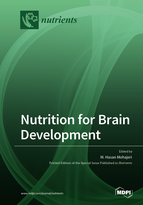Nutrition for Brain Development
A special issue of Nutrients (ISSN 2072-6643). This special issue belongs to the section "Nutritional Epidemiology".
Deadline for manuscript submissions: closed (31 May 2021) | Viewed by 66445
Special Issue Editor
Interests: aging; Alzheimer’s disease; neurodegeneration; ADHD; nutrition; gut–brain axis; drug development
Special Issues, Collections and Topics in MDPI journals
Special Issue Information
Dear Colleagues,
This Special Issue focuses on factors that are implicated in the development of the brain, and thus have the potential to influence its functions. On the one hand, the brain depends on a steady and sufficient supply of oxygen and dietary ingredients for proper functioning. On the other hand, genetic predispositions and epigenetic and environmental factors may influence brain development and function. Imbalance in any of these factors may lead to the manifestation of developmental disorders of young ages, compromised daily capabilities, or age-associated brain disorders.
The goal of this Special Issue is to publish state-of-the-art contributions discussing the role of nutritional compounds, genetic factors, etc., on brain development, its functions, and aging. Mechanistic as well as epidemiological studies in vitro, in vivo, and in human subjects will be considered for publication. We encourage the submission of original research articles, reviews, and meta-analyses. Potential topics may include, but are not limited to the keywords given below.
PD Dr. M. Hasan Mohajeri
Guest Editor
Manuscript Submission Information
Manuscripts should be submitted online at www.mdpi.com by registering and logging in to this website. Once you are registered, click here to go to the submission form. Manuscripts can be submitted until the deadline. All submissions that pass pre-check are peer-reviewed. Accepted papers will be published continuously in the journal (as soon as accepted) and will be listed together on the special issue website. Research articles, review articles as well as short communications are invited. For planned papers, a title and short abstract (about 100 words) can be sent to the Editorial Office for announcement on this website.
Submitted manuscripts should not have been published previously, nor be under consideration for publication elsewhere (except conference proceedings papers). All manuscripts are thoroughly refereed through a single-blind peer-review process. A guide for authors and other relevant information for submission of manuscripts is available on the Instructions for Authors page. Nutrients is an international peer-reviewed open access semimonthly journal published by MDPI.
Please visit the Instructions for Authors page before submitting a manuscript. The Article Processing Charge (APC) for publication in this open access journal is 2900 CHF (Swiss Francs). Submitted papers should be well formatted and use good English. Authors may use MDPI's English editing service prior to publication or during author revisions.
Keywords
- Nervous system
- Neurogenesis
- Brain development
- Brain aging
- Microbiome and brain
- Genetic modifications, polymorphisms
- Age-related brain dysfunction
- Dietary bioactives
- Malnutrition
- Nutrition and chronic conditions
- Genetic predisposition







